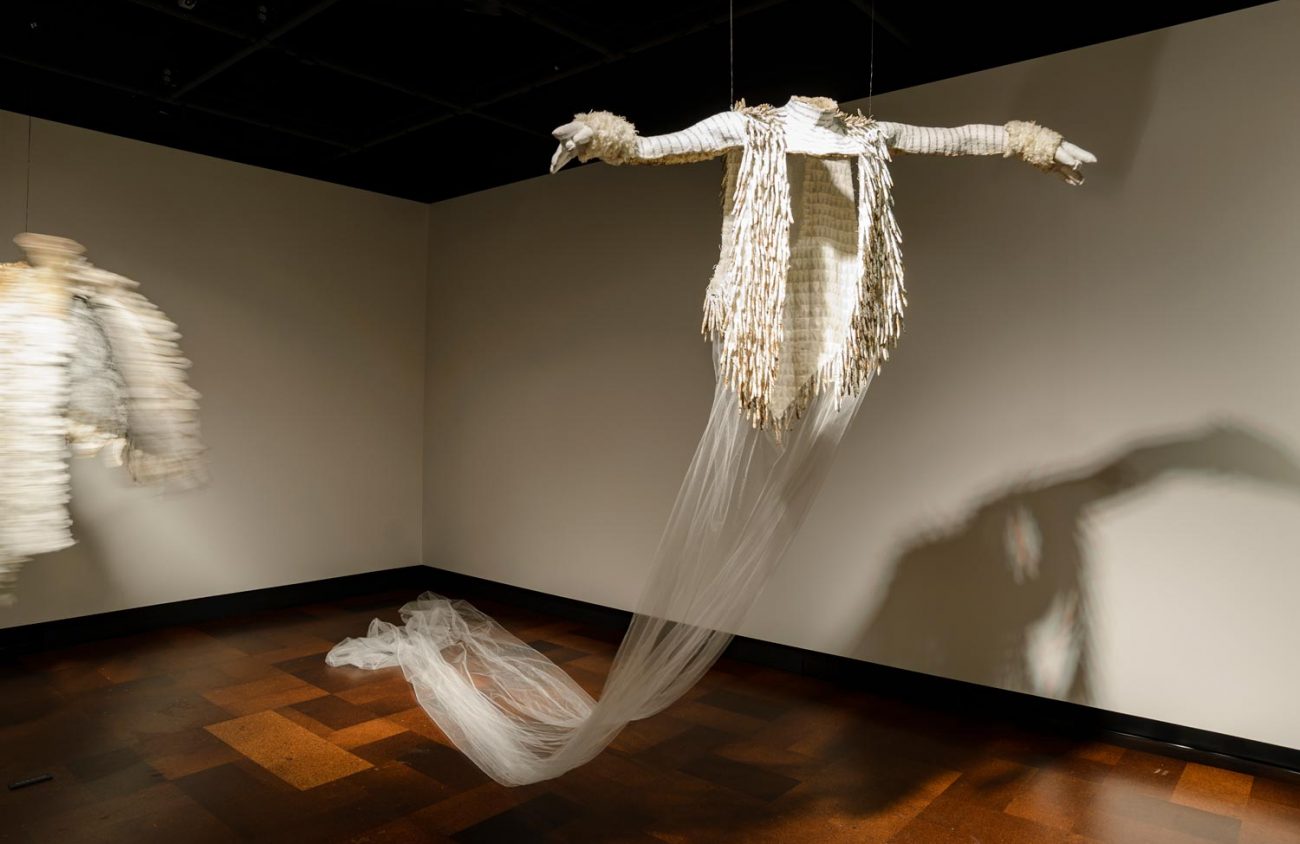If the titles of artworks in Barbara MacCallum’s Appropriating Science at the Jordan Schnitzer Museum of Art through Jan. 28 remind you of a movie called The Effects of Gamma Rays on Man-in-the-Moon Marigolds, as they do me, it’s because they are similarly titled after scientific investigations.
But MacCallum’s art isn’t about “mechanism for cloud spreading,” any more than the movie was about gamma rays or marigolds. The movie used a scientific experiment as a metaphor for how events affect people differently; MacCallum uses her scientist husband’s published papers as a medium for creating art.
In “Mechanism for Cloud Spreading in the DSMC Model I (Vest),” the artist rolled up pages of her husband’s papers and then assembled them to make a vest. The figure wearing the vest has outstretched arms and a long veil that flows when animated by a floor fan, but it’s missing a head and, for that matter, the rest of a body as well.
Suspended high from the ceiling, this work of art reads like a figure not quite human — more spiritual than earthly. And though the vest is made out of scientific papers, don’t expect to read it. The pages function as tightly wound fringe on a garment that can’t be read.
Each artwork, four figures total, is associated with an article of clothing or, in one case, wings. In “Mechanism for Cloud Spreading in the DSMC Model II (Wings),” the pages of scientific papers aren’t rolled up. They have been torn in pieces and fabricated into an elaborate winged torso.
This work is the only one that’s on a motor. The torso, like a top or a planet, is constantly revolving, and unless you’re willing to jog alongside it, reading any of the words is nearly impossible.
Even if the papers in the show weren’t rolled up or adhered to a motor and constantly in motion — even if you could read what was written on the pages — would you understand?
It’s often said that science has its own culture and language. So also with art, particularly contemporary art. Depending on your background, you may find one more approachable or easier to appreciate than the other.
Overall, the gallery where the exhibit is held looks less like a science lecture hall than it does a Vogue magazine layout. The space contains the makings of a high-end fashion shoot; lights throw dramatic shadows on the walls, a fan blows a long veil across the room and garments are displayed on elongated or fractured figures.
Appropriating Science is, according to the artist’s statement, a critique of how society values science more than art.
By appropriating the materials of science, MacCallum is “obliterating their usual function” and attempting to “reconfigure science into art.” The work evolved through a collaborative relationship with her husband. Casts of his body are incorporated as well as his papers, and I wonder how he feels having his body of work recycled out of existence.
I’m guessing he is fine with recasting it into art, since he was part of the process. But the question of whether our society appreciates art remains a complicated one.
On the one hand, a relatively small painting is sold at auctions for millions of dollars. On the other hand, art education is funded far less than science.
Our current moment, in which science seems to be devalued by our administration along with the arts, may bring about future collaborations between MacCallum and her husband, taking on the question of value where both art and science are concerned.
